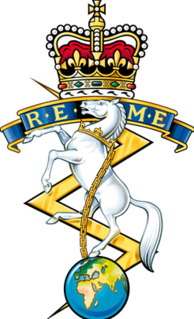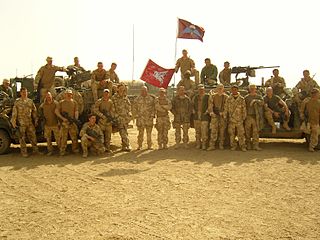Related Research Articles

The Royal Logistic Corps provides logistic support functions to the British Army. It is the largest Corps in the Army.
A commissariat is a department or organization commanded by a commissary or by a corps of commissaries.

The Corps of Royal Electrical and Mechanical Engineers is a corps of the British Army that maintains the equipment that the Army uses. The corps is described as the "British Army's Professional Engineers".

The Royal Corps of Transport (RCT) was a British Army Corps established to manage all matters in relation to the transport of men and material for the Army and the wider Defence community. It was formed in 1965 and disbanded in 1993; its units and trades were amalgamated into the Royal Logistic Corps. The Depot and Training Regiment RCT was at the former Buller Barracks in Aldershot garrison.

The Royal Army Service Corps (RASC) was a corps of the British Army responsible for land, coastal and lake transport, air despatch, barracks administration, the Army Fire Service, staffing headquarters' units, supply of food, water, fuel and domestic materials such as clothing, furniture and stationery and the supply of technical and military equipment. In 1965 its functions were divided between other Corps and the RASC ceased to exist; subsequently, in 1993, they in their turn became the "Forming Corps" of the Royal Logistic Corps.

The Royal Army Ordnance Corps (RAOC) was a corps of the British Army. At its renaming as a Royal Corps in 1918 it was both a supply and repair corps. In the supply area it had responsibility for weapons, armoured vehicles and other military equipment, ammunition and clothing and certain minor functions such as laundry, mobile baths and photography. The RAOC was also responsible for a major element of the repair of Army equipment. In 1942 the latter function was transferred to the Royal Electrical and Mechanical Engineers (REME) and the vehicle storage and spares responsibilities of the Royal Army Service Corps were in turn passed over to the RAOC. The RAOC retained repair responsibilities for ammunition, clothing and certain ranges of general stores. In 1964 the McLeod Reorganisation of Army Logistics resulted in the RAOC absorbing petroleum, rations and accommodation stores functions from the Royal Army Service Corps as well as the Army Fire Service, barrack services, sponsorship of NAAFI (EFI) and the management of staff clerks from the same Corps. On 5 April 1993, the RAOC was one of the corps that amalgamated to form The Royal Logistic Corps (RLC).

The Demountable Rack Offload and Pickup System (DROPS) is a family of logistics vehicles operated by the British Army, which consists of two vehicle types:
The role of the Commando Logistic Regiment (CLR), Royal Marines is to provide second line Combat Service Support to 3 Commando Brigade.

The Royal Australian Army Ordnance Corps (RAAOC) is the Corps within the Australian Army concerned with supply and administration, as well as the demolition and disposal of explosives and salvage of battle-damaged equipment. The Corps contains clerks, operator supplies, petroleum operators, parachute riggers and ammunition technicians. Members of the Corps are nicknamed Roaches.

562 Parachute Squadron Royal Corps of Transport (Volunteers) was a minor unit that supported 44th Parachute Brigade (V).
160 Transport Regiment Royal Logistic Corps (Volunteers), was a regiment of the Territorial Army in the United Kingdom.

The Royal Australian Corps of Transport (RACT) is a corps within the Australian Army. The RACT is ranked tenth in seniority of the corps of the Australian Army, and is the most senior logistics corps. It was formed on 1 June 1973 as an amalgamation of the Royal Australian Army Service Corps (RAASC) and Royal Australian Engineers Transportation Service. The RACT is responsible for the operation of army surface transport assets, movement control, terminal and postal services, and Army aspects of air logistic support.

15 Air Assault Support Squadron is a British Army logistic squadron, currently under 13 Air Assault Support Regiment RLC.

The ANZUK Ordnance Depot was established in 1971 to provide logistical support to Australian, New Zealand and British forces stationed in Singapore and Malaysia as part of ANZUK Force. It was commanded by a Royal Army Ordnance Corps officer of the rank of lieutenant colonel and staffed by Australian, New Zealand and United Kingdom personnel and Locally Employed Civilians. This organisation operated for only a short period. Australia changed Government in 1972 and the incoming Labor Government decided to withdraw Australia’s commitment to the region. This took effect in 1974 and was followed later by the withdrawal of the British forces. It was then decided that New Zealand should form its own Advanced Ordnance Depot, designated the New Zealand Advanced Ordnance Depot (NZAOD). This was the start of a commitment which was to last until December 1989.

The Defence School of Transport (DST) Leconfield is located at Normandy Barracks, Leconfield near Beverley, East Riding of Yorkshire in England.
Brigadier Charles Esmond de Wolff CB CBE was a British Army officer.
The Somerville Logistic Committee was established by General Sir William Jackson the then Quarter Master General (QMG) in 1974 to consider the re-structuring of the MOD (Army) Q Staffs and logistic services. It was chaired by Major General RM Somerville the then Vice Quarter Master General (VQMG). It reported in March 1975.

With the adoption of the Singapore strategy in the 1920s as a key cornerstone of Imperial Defence, Singapore and Malaya became the major British bases in the East, not only to defend British possessions in Asia, but also the Dominions of Australia and New Zealand, who also contributed a large portion of the construction costs.
Supply Technician is the Royal New Zealand Army Logistic Regiment trade responsible for providing Supply & Quartermaster support to the New Zealand Army within New Zealand or overseas.

MoD Feltham is a secure 30-acre (12 ha) military installation in Feltham, Middlesex.